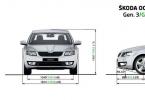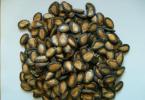This allows the inlet and outlet channels to be arranged in such a way that their length is reduced while simultaneously having a larger cross section. This significantly reduces pressure losses on the exhaust side. Optimum flow capacity is ensured by the special design of the common exhaust manifold, four pipes of which "serve" two cylinders each. The separation of the exhaust gas streams continues until it enters the turbine wheel. This creates a constant, backflow-free pressure on both volutes of the Twin Scroll turbocharger. The maximum boost pressure of the system is 1.5 bar. The use of Twin Scroll Twin Turbo technology with a specially designed common exhaust manifold further unleashes the potential for supercharging. The new M TwinPower Turbo engine is characterized by exceptionally sharp actuation and extremely high tractive power, which is already achieved at low revs and remains constant up to a high rev range. All this is accompanied by the amazingly powerful and booming engine sound characteristic of the BMW M version, which emphasizes its revving and sharp reaction to the addition of “gas”. The powerful V8 engine also has an appropriate cooling system, developed individually for each model. It includes, in particular, indirect cooling of the charge air, which further improves the technical potential of the engine in particularly dynamic driving conditions. The new TwinPower Turbo engine works with maximum efficiency. In addition to the High Precision Injection direct injection system, the M and BMW X6 M models are equipped with numerous BMW EfficientDynamics technologies: in addition to brake energy regeneration, this is demand-based control of the electric fuel pump, switchable air conditioning compressor, as well as volumetric flow control (and therefore also functioning depending on the needs) of the hydraulic fluid in the body roll suppression system. The models have an average EU fuel consumption of 13.9 liters per 100 kilometers. The CO2 emission of both models is 325 grams per kilometer. The vehicles comply with the US LEV II environmental standard and the requirements of the Euro 5 standard in Europe.
BMW TwinPower Turbo engines.
Sometimes an ardent sportsman, and sometimes an elegant companion. With powerful BMW TwinPower Turbo engines from the BMW EfficientDynamics range, the BMW 6 Series Gran Coupé looks impressive in every driving situation. And the combination of two turbochargers, VALVETRONIC system, Double-VANOS system and high-precision fuel injection system ensures excellent dynamics and efficiency.
BMW TwinPower Turbo 8-cylinder petrol engine.
At the heart of the impressive dynamics of the BMW 6 Series Gran Coupé is the phenomenal power of the BMW 650i engine. A light touch on the accelerator pedal is all it takes to unleash the BMW TwinPower Turbo 8-cylinder engine, which accelerates from 0 to 100 km/h in just 4.6 seconds thanks to two turbochargers, VALVETRONIC and Double-VANOS systems and high-precision fuel injection.
The BMW 650i xDrive reaches the same mark in 4.4 seconds. Along with an impressive power of 450 hp. With. and a maximum torque of 650 Nm, the BMW TwinPower Turbo 8-cylinder petrol engine impresses with modest fuel consumption: Equipped with automatic engine stop and start, as well as other technologies from the BMW EfficientDynamics program, the BMW 650i engine consumes an average of 8.6 to 8. 8 l/100 km (9.2-9.4 l/100 km with xDrive) and its CO2 emissions range from 199 to 206 g/km (215-219 g/km with xDrive). This means that the BMW 650i and BMW 650i xDrive engines comply with the EU6 emission standard.
BMW TwinPower Turbo inline 6-cylinder petrol engine.
Enormous power and smooth operation: the potential of the BMW TwinPower Turbo 6-cylinder in-line petrol engine is already legendary. Thanks to its combination with various BMW EfficientDynamics technologies, the fuel consumption of the BMW 640i engine has been further reduced.
Result: Consumption of just 7.5-7.8 l/100 km (7.9-8.2 l/100 km with xDrive), CO2 emissions of 174-182 g/km (184-192 g/km with xDrive) ) and acceleration from 0 to 100 km / h in 5.4 s (5.3 s with xDrive) with an impressive power of 320 hp. With. and maximum torque of 450 Nm.
The BMW TwinPower Turbo concept combines revolutionary technology with innovative fine-tuning. The TwinScroll turbocharger and VALVETRONIC system supply fresh air to the combustion chamber. The high-precision fuel injection system creates a precisely balanced fuel-air mixture in milliseconds, while the Double-VANOS system optimizes engine power in accordance with rpm. The result: maximum economy and power over a wide rev range and consistently crisp engine response. This is the kind of engine you want in a BMW 6 Series Gran Coupé. This means that the BMW 640i and BMW 640i xDrive engines comply with the EU6 emission standard.
BMW TwinPower Turbo inline 6-cylinder diesel engine.
The technical characteristics of the BMW 640d engine speak for themselves: fast power output with low fuel consumption. All this is made possible thanks to the innovative BMW TwinPower Turbo system, which combines common rail direct injection and a multi-stage turbocharger with variable turbine geometry.
This solution allows you to significantly reduce fuel consumption while increasing power. The high torque of 630 Nm is already achieved at 1500 and 2500 rpm. With supremely smooth operation and responsiveness, the BMW TwinPower Turbo inline 6-cylinder diesel engine develops 230 kW (313 hp) for impressive traction. Working in conjunction with other BMW EfficientDynamics technologies, the new engine delivers even lower fuel consumption of just 5.7-5.4 l/100 km (5.6-6.0 l/100 km with xDrive), while CO2 emissions are 143-152 g/km (with xDrive 149-158 g/km). Acceleration from standstill to 100 km/h is just 5.4 seconds (with xDrive system - just 5.2 seconds). This means that the BMW 640d and BMW 640d xDrive engines comply with the EU6 emission standard.
The innovative 3-cylinder petrol engine with its exceptionally smooth operation, the 4-cylinder petrol engine and the multiple winner of the annual international Engine of the Year award, the BMW TwinPower Turbo inline 6-cylinder petrol engine set new standards. These new generation engines are even more economical, environmentally friendly and powerful than their predecessors. The innovative technologies that are the cornerstones of the BMW EfficientDynamics strategy combine the latest fuel injection systems, Valvetronic including Double-VANOS and innovative turbocharging technologies. The result is particularly efficient powertrains that showcase BMW's expertise in engine technology.
BMW TwinPower Turbo diesel engines
BMW Twin Power diesel engines embody the principles of BMW EfficientDynamics: a combination of outstanding fuel efficiency, increased power and excellent driving characteristics. Vehicles with diesel engines can serve as models of efficiency and dynamics. At the same time, the BMW TwinPower Turbo 3-cylinder diesel engines are ideal entry-level powertrains; The innovative 4-cylinder BMW TwinPower Turbo engines and the powerful 6-cylinder BMW TwinPower Turbo diesel engines do their job with exceptionally low emissions and frictional losses. The diesel engines of the BMW EfficientDynamics family with a lightweight aluminum design are equipped with variable geometry turbochargers and the latest generation CommonRail direct fuel injection system.
twinturbo And biturbo what is the difference and what are the differences
Contrary to the beliefs of some "experts", the name of the system biturbo or twinturbo do not display the turbine operation scheme - parallel or sequential (sequential).
For example, in a Mitsubishi 3000 VR-4, the turbocharging system is called TwinTurbo (twinturbo). The car has a V6 engine and it has two turbines, each of which uses the energy of the exhaust gases from its three cylinders, but they blow into one common intake manifold. For example, German cars have systems similar in working principle, but they are not called twinturbo (twinturbo), but BiTurbo (BiTurbo).
Two turbines are installed on a Toyota Supra with an inline six, the turbocharging system is called TwinTurbo (twinturbo), but they work in a special sequence, turning on and off using special bypass valves.
The Subaru B4 car also has two turbines, but they work in series: at low speeds, a small turbine blows, and at high speeds, when it fails, a second larger turbine is connected.

Let's take a look at both systems now. bi-turbo (biturbo) And twinturbo (twinturbo), or rather, what they write about them in “these your Internets”:
bi-turbo (biturbo) - a turbocharging system, which consists of two turbines connected in series. In system biturbo two turbines are used, one small and the other larger. A small turbine spins faster, but at high engine speeds, a small turbine cannot cope with compressing the air and creating the right pressure. Then a large turbine is connected, adding a powerful charge of compressed air. Consequently, the delay (or turbolag) is minimized, and a smooth acceleration dynamics is formed. Systems biturbo not a very cheap pleasure and are usually installed on high-end cars.
System biturbo (bitrubo) can be installed as on a V6 engine, where each turbine will be installed on its own side, but with a common intake. Either on an in-line engine, where the turbine is installed by cylinders (for example, 2 for a small and 2 for a large turbine), or sequentially, when a large pipe is first installed on the exhaust manifold, and then a small one.

twin turbo (twinturbo) - this system is different from bi-turbo in that it is not aimed at reducing turbo lag or equalizing acceleration dynamics, but at increasing performance. In systems twinturbo (twinturbo) two identical turbines are used, respectively, the performance of such a turbocharging system is more efficient than systems with a single turbine. In addition, if you use 2 small turbines, similar in performance to one large one, you can reduce unwanted turbolag. But this does not mean that no one uses two large turbines. For example, a serious dredge might use two large turbines for even more performance. System twin turbo can work both on V-shaped motors and on in-line ones. The sequence of turning on the turbines can vary, as well as on biturbo systems. 
In general, for even more fun, no one bothers you to stick 3 (!) Turbines or more at once. The goal is the same as for twinturbo. I must say that this is often used in drag racing and never on stock cars.



